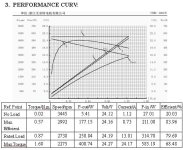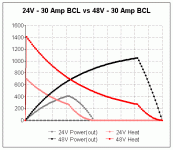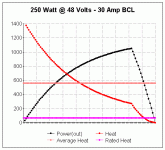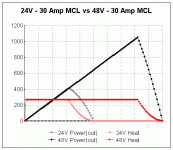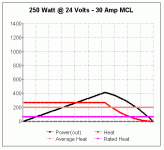dirty_d said:... doubling voltage quadruples power since doubling voltage also doubles current at any particular rpm. the force(torque) required to overcome air resistance increases with the square of velocity so the power required increases with the cube of velocity. ..
The part about doubling the current would be true if there was no current limiter in the controller. The limiter will keep the current below the set point. When the controller hits the limit, the torque is prevented from going as high as it would without a limiter.
The part about increased air resistance is definitely true, so calculate you power requirements accordingly.
If you increase the voltage (and rpm) of a motor, in most cases the efficiency will go to crap quickly at higher rpms. This is a function of motor design and will vary with the type of motor.
If you want to keep the motor from overheating, you would need to reduce the current as you increase the rpm above the designed operating speed. I don't think the motor simulators reflect this very well. With a hubmotor, there's practically no windage loss and the rpms are so slow even when overvolted that the core loss increase is still fairly negligible.
With a geared motor that runs at a higher rpm to start with, the core and windage losses can get nasty at, say, double the normal rpm. Again, this is largely determined by the motor construction and the type of iron and magnets used. A coreless motor will operate much more efficiently at higher rpm.
I think Safe is just going to have to build a motor side current limiter and test it out. One made with the Allegro hall current sensor would allow moving the sensor to either the battery or motor side.
Personally, I like rocket take-offs and would not be happy with a severely restricted motor. Motor temperature monitoring with feedback to the current limiter seems like an ideal solution to me. Full juice until the motor starts getting hot, then it backs off gradually to prevent overheating. Perhaps the next version of the CA will have this feature.


